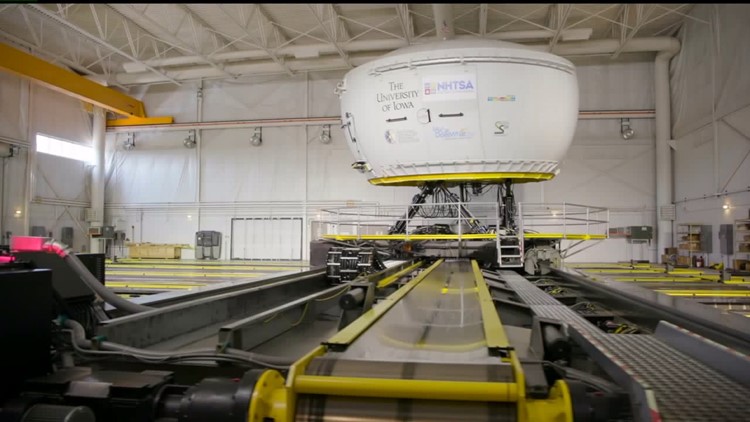CORALVILLE, Iowa-- Self-driving cars are quickly becoming a reality as researchers develop technologies to make them safer and more accurate. But what most people might not know is that a research center in Eastern Iowa has been paving the way for self-driving cars for the last 25 years.
"We're very passionate about creating the next generation of technologies that can prevent the car crash of the future or lessen its severity," said Daniel McGehee, director of the National Advanced Driving Simulator (NADS) at the University of Iowa.
McGehee said the safety features in cars today, such as brake assist, automatic emergency braking and lane-departure warning, were tested at NADS 10 years ago.
"So we really have to look another 20 years in the future to be able to see when these technologies (for self-driving cars) will be implemented," he said.
One of the big research projects right now is high-definition maps.
"People may be familiar with Google cars that drive around with these big masts on them that have cameras and spinning lasers," McGehee explained. "We use a contractor that has those kinds of vehicles to do that, and they scan our roads down to detail."
These special maps aren't for people to use, but they're designed to help self-driving cars stay on the road.
McGehee said GPS maps can only pinpoint a vehicle within a 6-foot radius of where it actually is. That's a lot of room for error. High-definition maps are accurate, within seven centimeters of accuracy.
The NADS team has already mapped Interstate 380 from Coralville to Cedar Rapids.
"The next step is really to expand those maps nationwide..." McGehee said. "What we really need is the next generation of digital highways so these vehicles can stay on the road, navigate across state lines, across the country."
U.S. Congressman Dave Loebsack is on board. He's introduced a bill that would use $30 million from the U.S. Department of Transportation to fund three pilot programs for high-definition maps. Research centers across the country could apply and, if selected, would continue researching high-definition maps and preparing them for implementation.
"It [self-driving cars] does create a little bit of fear in people," the Iowa representative said. "So we gotta make sure that, if this stuff does happen, it's gonna be a 100 percent safe. We can't have it be 99 percent safe or 95 percent safe. It's gotta be 100 percent safe."
Rep. Loebsack said he wants to prevent accidents from happening with self-driving cars, like when a pedestrian was struck and killed by a self-driving Uber car in Arizona earlier this year. He wants to make sure technology is ahead of the curve.
"This is something I think is going to be a part of our future, there's no question about that," he said.
Even as researchers and government officials are preparing for the future, some in the car industry are skeptical.
"[Self-driving cars have] a lot of learning yet where I still think you need that human interaction," said Todd Hopkins, general manager at Lexus of the Quad Cities. "I'm skeptical if [cars will] all be self-driving cars, but I think they'll have those safety features where they can stop itself, it can drive itself, it can keep it in its own lane, and it can have all those features."
Hopkins has worked at Lexus for 27 years. He said he's seen a lot of changes in that time.
"I remember the first time we had anti-lock breaks," he said. "And people going, 'What's happening to the breaks?' ... And to think that we've come to the point where a car can drive all by itself is pretty incredible."
Hopkins said self-driving cars have the potential to reduce accidents.
"There's so many people that are distracted nowadays, whether it's due to cell phones or it's just day to day work they're thinking of," Hopkins said. "They don't notice things as quickly as a car or computer can."
Even as technologies change and advance every day, Hopkins and McGehee said there's a long way to go, especially when it comes to high-definition maps.
"The easy part is actually the driving and the scanning part," McGehee said. "It's the processing of all of that data that is really time-consuming. It can take six months or even a year to get a whole stretch of road processed down to those seven centimeters of resolution."
McGehee said as their equipment improves, the process will be faster. He thinks we're still several decades away from seeing self-driving cars on every street.
The Iowa Department of Transportation expects to start seeing fully-automated cars on the road by 2030. It has a plan in place to make sure these automated vehicles have accurate, up-to-date information for driving.



